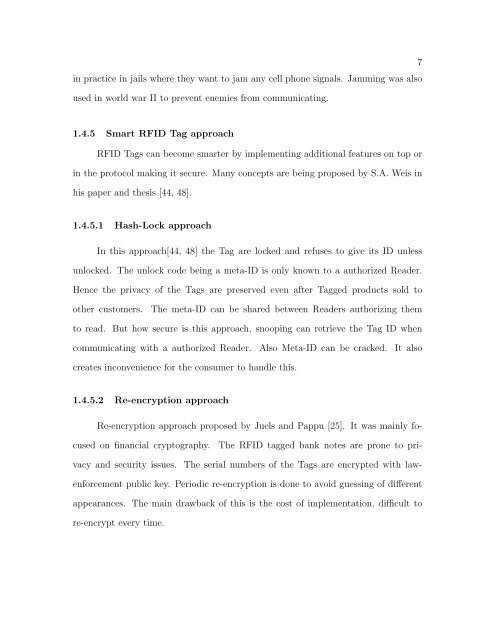BLOCKING READER: DESIGN AND IMPLEMENTATION OF A ...
BLOCKING READER: DESIGN AND IMPLEMENTATION OF A ...
BLOCKING READER: DESIGN AND IMPLEMENTATION OF A ...
You also want an ePaper? Increase the reach of your titles
YUMPU automatically turns print PDFs into web optimized ePapers that Google loves.
in practice in jails where they want to jam any cell phone signals. Jamming was also<br />
used in world war II to prevent enemies from communicating.<br />
1.4.5 Smart RFID Tag approach<br />
RFID Tags can become smarter by implementing additional features on top or<br />
in the protocol making it secure. Many concepts are being proposed by S.A. Weis in<br />
his paper and thesis [44, 48].<br />
1.4.5.1 Hash-Lock approach<br />
In this approach[44, 48] the Tag are locked and refuses to give its ID unless<br />
unlocked. The unlock code being a meta-ID is only known to a authorized Reader.<br />
Hence the privacy of the Tags are preserved even after Tagged products sold to<br />
other customers. The meta-ID can be shared between Readers authorizing them<br />
to read. But how secure is this approach, snooping can retrieve the Tag ID when<br />
communicating with a authorized Reader. Also Meta-ID can be cracked. It also<br />
creates inconvenience for the consumer to handle this.<br />
1.4.5.2 Re-encryption approach<br />
Re-encryption approach proposed by Juels and Pappu [25]. It was mainly fo-<br />
cused on financial cryptography. The RFID tagged bank notes are prone to pri-<br />
vacy and security issues. The serial numbers of the Tags are encrypted with law-<br />
enforcement public key. Periodic re-encryption is done to avoid guessing of different<br />
appearances. The main drawback of this is the cost of implementation, difficult to<br />
re-encrypt every time.<br />
7
















